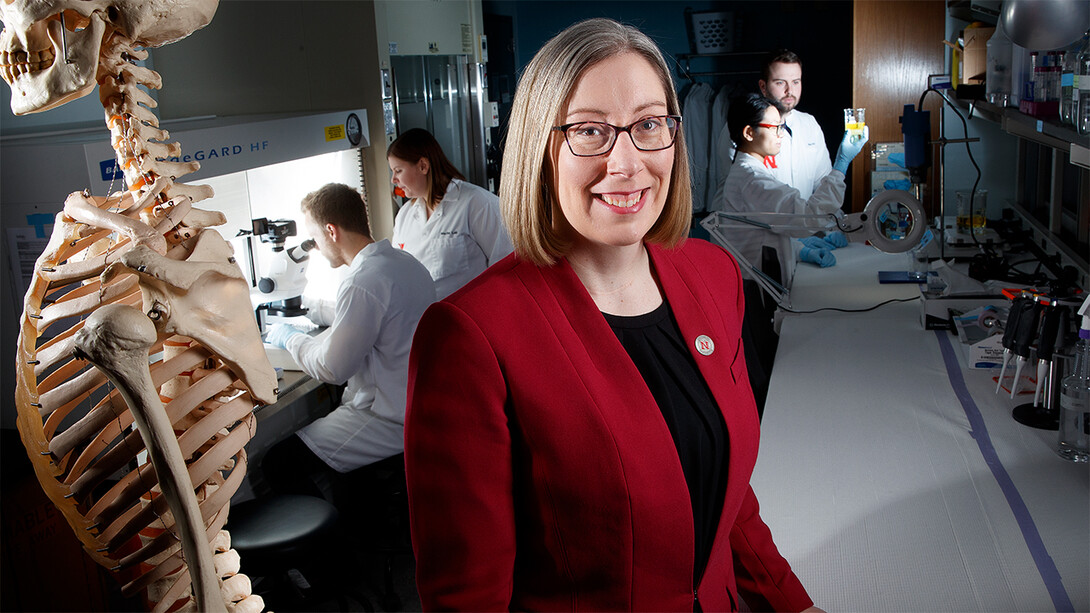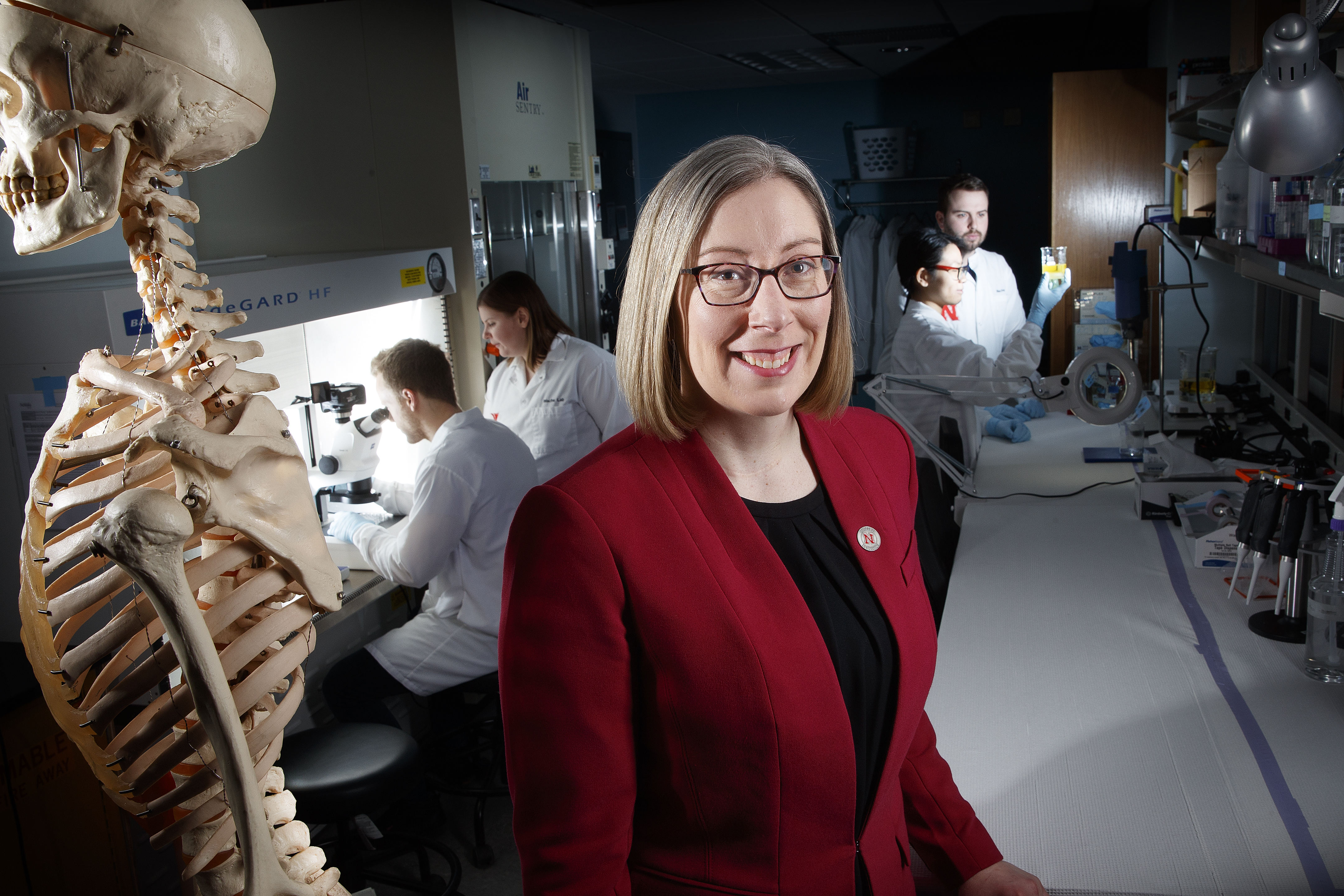
For all of the pain that stems from the lower back — an instigator of chronic distress in more than 500 million people worldwide — the details behind that pain have long bedeviled researchers.
Supported by a new five-year, $1.6 million grant from the National Institutes of Health, Nebraska’s Rebecca Wachs and colleagues will aim to pinpoint the impacts of a three-pronged offensive that degenerating discs can wage on the lower back.
“Once we understand more about the mechanisms (of the pain), we can actually develop targeted treatments,” said Wachs, assistant professor of biological systems engineering at the University of Nebraska–Lincoln.
With a gelatinous center surrounded by concentric rings of collagen fibers, the discs residing between vertebrae are sometimes likened to miniature jelly donuts. The most notorious disc-related injuries arise when the gooey nucleus begins pushing against the perimeter, producing a bulging disc, or compressing to the point that it leaks out and causes a herniated disc. Still, the majority of injuries to the shock-absorbing, load-bearing discs — especially those wedged between the five lumbar vertebrae of the lower back — come from subtle degeneration that progresses over decades, worsening with age.
Normally, the cells of a healthy disc will churn out compounds that inhibit the growth of nerves into it. But as a disc degenerates, it sometimes stops producing those inhibitors and begins producing inflammatory proteins that eat away at its tissue, yielding fissures in its outer rings. That combination ultimately allows nascent nerves to plunge into and through the outer disc.
Prior research has indicated that certain inflammatory proteins can then attach to the emerging nerve receptors and directly stimulate pain signals. The widening fissures, meanwhile, can compromise the biomechanical integrity of the disc, introducing more movement that can also stimulate nerves and lead to pain.
Unfortunately, the cascading, interrelated nature of disc degeneration has complicated efforts to determine how much blame to cast on each of the potential culprits: nerves, inflammation and mechanics. The fact that roughly one-third of the older adults with disc degeneration will experience no pain only muddies the issue, Wachs said. An absence of blood vessels in the discs likewise limits the systemic delivery and evaluation of pharmaceutical treatments available to other joints.
“A lot of the other joints have substantial treatment options,” she said. “There are some decent therapeutics or surgical interventions that treat some of those chronic conditions, whereas the spine is still kind of the unknown.”
In their own efforts to resolve that unknown, Wachs and her team recently managed to recreate in rats the mild, ibuprofen-worthy degeneration of discs that afflicts so many people. That work has now primed the researchers to isolate and study the three possible pain-driving variables in turn.
The team previously observed signs of mild pain when nerves sprouted into the normally nerve-free discs, indicating a correlation between the two. To examine whether that correlation is hinting at causation, the team will administer nerve-inhibiting compounds to degenerating discs. If the nerves are directly contributing to disc-related distress, the team should see less pain in the inhibited cases than when nerves are instead allowed to encroach on the discs.
“Spinal degeneration doesn’t necessarily mean painful spinal degeneration,” Wachs said. “So we’re trying to understand the role of the nerves, specifically, in this type of low-back pain.”
Wachs and her colleagues, including Nebraska’s Amanda Ramer-Tait, will also try to tease apart the influences of inflammation versus mechanical stress when nerves are present. Because the nerves feature receptors that are stimulated exclusively by inflammatory proteins or mechanical forces, the team will strategically activate and block those respective classes of receptors, then analyze any corresponding changes in pain-related behavior.
Given that older adults are more susceptible to disc degeneration, the team will study the three potential offenders in both younger rats and those that are the human equivalent of roughly 45 years old.
“When we get older, we don’t heal the same,” Wachs said. “Maybe there are even different (pain-related) mechanisms or cascades that occur.”
As a former college athlete who has endured her share of orthopedic issues, and whose family has its own history of back problems, Wachs said she’s hopeful the spinal sleuthing will yield insights that eventually inform therapeutics.
“I feel like we’ll have a better understanding of what we’re trying to target, and then we can leverage knowledge from other fields or translate what we already know,” she said. “The thing that I’m most interested in is translating this to patients — trying to get as close as we can to that — even if I’m not the person actually doing the translation. That’s probably the most exciting thing for me.”
A close second? The grant, which is funded by the National Institute of Arthritis and Musculoskeletal and Skin Diseases, will enable Wachs to bring two doctoral students aboard the project.
“That’s also a big part of why I do this work, is getting to watch students grow and learn — to train them,” she said, “and have them solve the problems along with me.”








